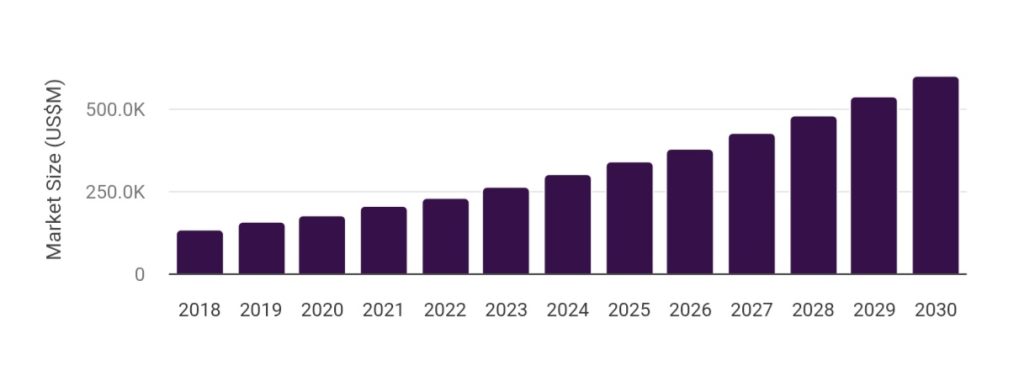Key Takeaways:
- Bored Ape Yacht Club creator Yuga Labs is launching its much-awaited Otherside metaverse on Nov. 12.
- The project could be Web3’s last big swing at proving that NFTs and virtual worlds still matter.
- But analysts say the metaverse ship has sailed.
Bored Ape Yacht Club creator Yuga Labs will launch its much-awaited metaverse project ‘Otherside’ on Nov. 12, in a desperate effort to reignite interest in the infamous monkey-themed NFT brand and in virtual worlds.
The Florida-based company raised $450 million at a $4 billion valuation in 2022 to build Otherside, a 3D virtual world that combines gaming, social networking, and blockchain tech, in particular, non-fungible tokens (NFTs).
Since then, Yuga Labs has said very little in public about the project. However, recently the team revealed that Otherside will finally be released in November after two years of development.
The company says users will be able to join Otherside using traditional email or a crypto wallet. Players can explore, build, and interact like they would in Fortnite, Roblox or Minecraft, per industry media reports.
But unlike those rival platforms, Otherside also allows users to buy and trade digital assets such as NFTs, including Bored Apes, the cartoonish monkey characters that once defined crypto culture in the early 2020s.
The project launch comes at a time when interest in the metaverse and NFTs has plummeted. Prices of Bored Ape NFTs, once the ultimate status symbol, selling for more than $400,000 each, have slumped 90% from their peak.
So, can Otherside help bring the metaverse — a virtual world where people can interact, work, and create using technologies like virtual reality — back to life? Many people believe the metaverse is dead, encumbered by AI.
Resurrecting the Metaverse
“It would be difficult for any one company to revive interest in the metaverse to the level of 2021,” Sasha Barrie, a former Bored Ape Yacht Collection (BAYC) holder, told Cryptonews.
“That hype will likely never come back, but the NFT tech and various applications of it will continue growing,” she added.
Barrie said Yuga Labs’ continued interest in the metaverse “gives hope”, but warned against expecting a mass revival.
“Yuga does not command the attention anymore. Even at the height of its power, it only really moved the needle inside crypto. Mainstream’s metaverse was then, and remains, in Roblox and Minecraft.”
Yuga Labs chief product officer Michael Figge described Otherside as “one of the most ambitious projects ever attempted in the space,” according to The Verge, which first reported the news.
But analysts say the project will serve as a test for whether gaming that integrates blockchain tech, complete with a digital currency, NFT avatars and tokenized land, can reach users outside of early crypto adopters.
“The first wave of the metaverse was driven by speculation and novelty,” Nokkvi Dan Ellidason, the CEO of monetized game launcher and gaming ecosystem Gaimin, tells Cryptonews.
“The next wave will be powered by utility, accessibility, and real engagement,” he said, adding:
“If Yuga Labs can make Otherside fun and frictionless, they can absolutely reignite interest. But the relevance cycle no longer responds to hype; it responds to value.”
Catie Romero Finger, CEO of Web3 advisory firm BABs, concurred, saying the next generation of virtual worlds must offer true utility, including things like gameplay loops and tokenized economies, not speculation.
“The metaverse hype cycle peaked and crashed,” Romero Finger told Cryptonews. “Stand-alone narratives like a non-fungible token as a JPEG or the metaverse as a ‘virtual world’ aren’t compelling anymore.”
“If they [Yuga Labs] are creating something that … delivers meaningful interoperability or player-driven creation, they might be able to reignite a niche audience yearning for this narrative return. People don’t want metaverses; they want experiences with utility.”
Bored Ape Yacht Club: A Brand in Decline
Yuga Labs turned NFTs into a cultural storefront when it launched during the 2021 bull market. Its Bored Ape Yacht Club collection, 10,000 images of algorithmically generated primates, attracted A-list celebrity buyers like Eminem, Stephen Curry, Jimmy Fallon, and others.
The NFTs became a membership card, granting access to exclusive online events, merchandise, and music deals. Eminem and Snoop Dogg even performed together as their Bored Apes in the metaverse.
But after the crypto crash of 2022 and a long bear market that wiped out most NFT valuations, the BAYC brand, which topped OpenSea NFT sales with about $4.8 billion in transaction volume, began to fade.
For example, a Bored Ape NFT Justin Bieber bought for $1.3 million in 2021 is reportedly now worth just $60,000. Otherside represents a creative pivot and a reputational gamble for Yuga Labs. As Barrie, the ex-BAYC owner, notes:
“The BAYC brand has lost most of its power. But the club still has a small but loyal group of holders, who have some pull in the space. If Otherside is actually great, it will have a strong initial community that can help it grow.”
Barrie said the “very loyal” following, along with Yuga’s high-profile investors, including Andreessen Horowitz and Animoca Brands, may give Otherside a boost. But keeping the momentum will be a lot more difficult.
“Who knows, Otherside may become the first game built the ‘Web3 way,’” she said. “It’s extremely difficult to build a successful game. I would love to be proven wrong, but it’s hard to imagine lightning striking Yuga twice.”
Not everyone agrees. Irina Karagyaur is the co-founder and CEO of ecosystem growth agency BQ9. She told Cryptonews that Otherside is an opportunity for Yuga Labs to reposition itself for a more mature market.
“I strongly believe they can [succeed],” said Karagyaur, who is also an expert contributor to the UN’s International Telecommunications Union (ITU) Focus Group on the Metaverse.
“The Bored Ape brand and its community are one of the most established and resilient in the NFT space. Endorsed by some of the most reputable leaders in Web3, BAYC has managed to build a strong community culture known for exclusivity and high-quality events, which drive public demand.”
Otherside Moves From Speculation to Strategy
Karagyaur said Yuga’s acquisition of NFT collections Meebits and Crypto Punks brought blue-chip IPs under one roof, which could underpin cross-collection interoperability, one of the key promises of a true metaverse.
She also cited favorable industry trends. According to data from Horizon, the global gaming industry is expected to grow at a rate of 12% per year, from $300 billion in 2025 to $600 billion by 2030, led by mobile, cloud, and social gaming.
Meanwhile, “the creator economy is growing even faster, with creator earnings forecast to triple to $500 billion in the same period. So, for the time being, BAYC won’t lack demand or opportunities,” Karagyaur said.

But she warned that scaling Otherside to mass adoption would require a lot of money. “Reaching 100 million active users could cost $300 million to $500 million in marketing and incentives alone,” the BQ9 CEO detailed.
“It’s a long-term play, but if Otherside connects the dots between gaming, social engagement, and creator economies right, Yuga Labs will redefine what the metaverse means in this new cycle.”
Romero Finger, the BABs cofounder, insisted that the “only way” to bring the Bored Ape brand back to life is to pivot from exclusivity to utility. Yuga Labs can leverage existing holders to turn Apes into say access tokens for real benefits, such as revenue-sharing or IP licensing tools, she said.
“Without that, it remains a nostalgic artifact of 2021 speculation.”
Making Web3 Invisible to Metaverse Users
Otherside’s advantage is in its integration of NFTs and crypto wallets, allowing players to buy, sell, and own in-game assets. Karagyaur said the feature could unlock new digital economies that help spur the metaverse.
“Technically, it enables verifiable ownership, secondary markets, and user-driven economies that centralized games just can’t replicate.”
“But in practice,” she added, “this advantage only materializes if the experience is frictionless. When wallet setup, asset management, or speculation overshadow gameplay, that edge disappears.”
Karagyaur said, “The real opportunity lies in making Web3 invisible to the user,” that is, embedding ownership seamlessly into gameplay without requiring players to interact with blockchain mechanics directly.
Four years since Mark Zuckerberg renamed Facebook to Meta to reflect his then-strategic shift to the metaverse, the concept has become one of tech’s biggest failures in recent memory.
Unable to meet its lofty promises, the billions that once flowed into the sector have dried up, and public interest is down badly.
In 2024, trading volume and sales counts for metaverse NFT projects reached their lowest levels since 2020, with volumes slumping 80% and sales crashing 71% from a year earlier, according to DappRadar.
The post Bored Ape NFTs Return With ‘Otherside’. Can They Save the Metaverse? appeared first on Cryptonews.


 (@SteveKBark)
(@SteveKBark)